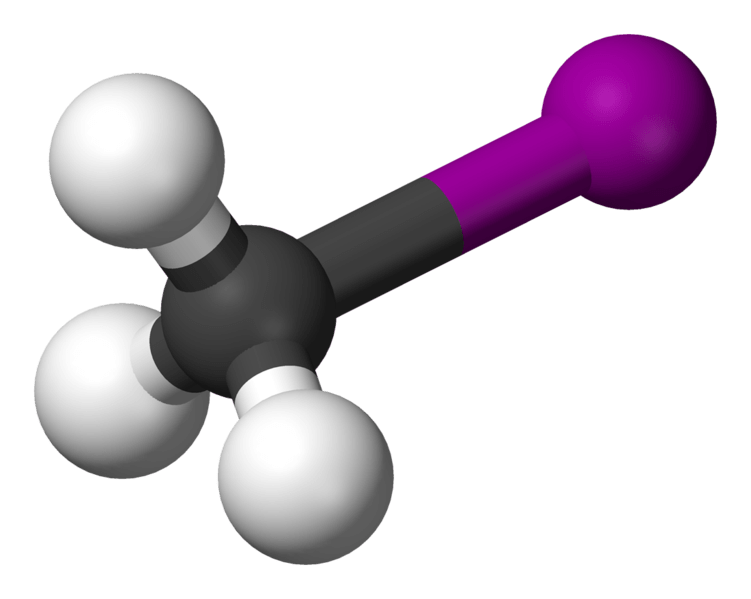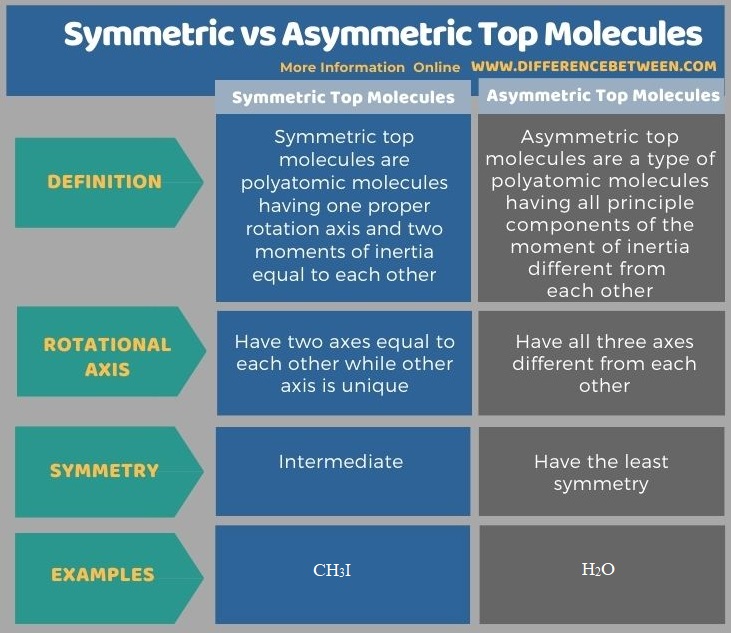Difference Between Symmetric and Asymmetric Top Molecules
Table of Contents
The key difference between symmetric and asymmetric top molecules is that symmetric top molecules have one proper rotation axis and two moments of inertia that are equal to each other whereas asymmetric top molecules have all the principal components of the moment of inertia different from each other.
The term symmetric and asymmetric top molecules come under the classification of polyatomic molecules on the basis of the shape of the momental ellipsoid and the pure rotation spectra. Generally, polyatomic molecules have complex rotational spectra. We can divide these molecules into four classes in order to interpret the spectra. This classification is done based on the shape of the moment of inertia ellipsoid of the molecule. The four classes include linear molecules, spherical top molecules, symmetric top molecules, and asymmetric top molecules.
CONTENTS
1. Overview and Key Difference
2. What are Symmetric Top Molecules
3. What are Asymmetric Top Molecules
4. Side by Side Comparison – Symmetric vs Asymmetric Top Molecules in Tabular Form
5. Summary
What are Symmetric Top Molecules?
Symmetric top molecules are polyatomic molecules having one proper rotation axis and two moments of inertia equal to each other. In other words, symmetric top molecules have two principal moments of inertial equal while the third is unique. We can further subdivide this category into two groups as prolate symmetric top molecules and oblate symmetric top molecules.

Figure 01: Shape of CH3I Molecule
An example of prolate symmetric top molecules is CH3I. It can be obtained by replacing a hydrogen atom from methane molecule by an iodine atom. This replacement causes the reduction of the symmetry of the molecule from Td to C3v. When we consider the C3 axis (or IA axis), the atoms that contribute to the rotation are only the light hydrogen atoms. Therefore, the moment of inertia is smallest along this axis of the molecule. There are two other axes (IB and IC) that are perpendicular to this C3 axis and these two perpendicular axes are equal to each other. Hence, IA<IB=IC. Linear molecules is a special case of the prolate symmetric top molecules because they have their IA = 0. Moreover, the oblate symmetric top molecules have their IC as the largest axis while IA equals IB. Therefore, we can give this relationship as, IA=IB<IC.
What are Asymmetric Top Molecules?
Asymmetric top molecules are a type of polyatomic molecules having all principle components of the moment of inertia different from each other. In other words, a molecule becomes an asymmetric top molecule if its higher-order rotation axis is C2 or if there is no proper rotation axis. Therefore, we can say that this is the least symmetric class of molecules.

Figure 02: Water Molecule
When considering the relationship between the axes of the molecule, it has IA ≠ IB ≠ IC. Some examples of this type of molecules include H2O, C2H2F2, etc.
What is the Difference Between Symmetric and Asymmetric Top Molecules?
Symmetric and asymmetric top molecules are two types of polyatomic molecules. The key difference between symmetric and asymmetric top molecules is that symmetric top molecules have one proper rotation axis and two moments of inertia that are equal to each other whereas asymmetric top molecules have all the principal components of the moment of inertia different from each other. While symmetric top molecules have two axes equal to each other and the other axis is unique, asymmetric top molecules have all three axes different from each other.
Below infographic summarizes the differences between symmetric and asymmetric top molecules.

Summary – Symmetric vs Asymmetric Top Molecules
Polyatomic molecules can be divided into four groups as linear molecules, spherical top molecules, symmetric top molecules, and asymmetric top molecules, based on their rotational spectra. The key difference between symmetric and asymmetric top molecules is that symmetric top molecules have one proper rotation axis and two moments of inertia that are equal to each other whereas asymmetric top molecules have all the principal components of the moment of inertia different from each other.
Image Courtesy:
1. “Iodomethane-3D-balls” By Benjah-bmm27 – Own work (Public Domain) via Commons Wikimedia
2. “Water Molecule Structure” By AbdullahAlturki99 – Own work (CC BY-SA 4.0) via Commons Wikimedia
ncG1vNJzZmivp6x7pbXFn5yrnZ6YsqOx07CcnqZemLyue8OinZ%2Bdopq7pLGMm5ytr5Wau26%2F2KaknqyinrBurc2dZJqrqaK6psDRoppmrJ%2Bleq67y56arqSVqHw%3D